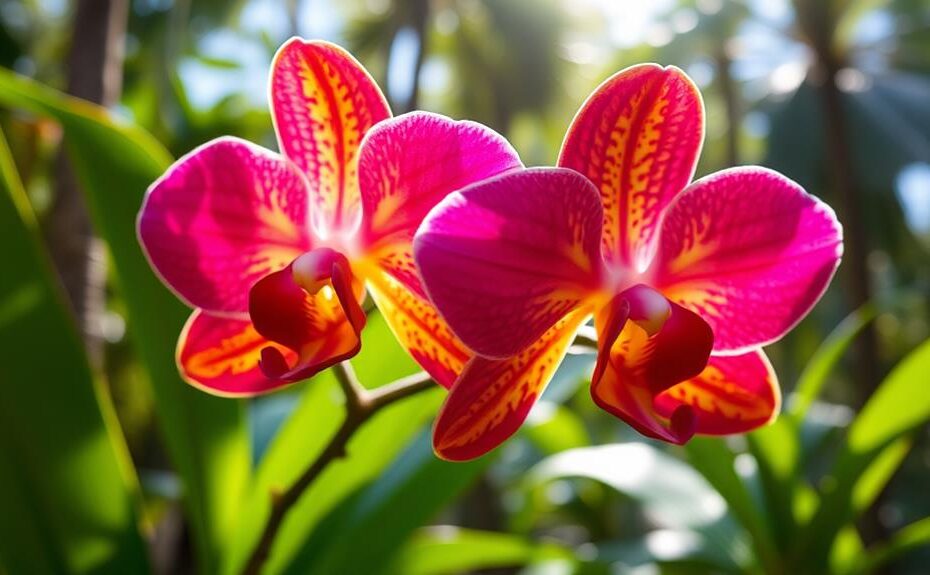The Waling-Waling Orchid: A Rare and Endangered Species
The Waling-Waling orchid, scientifically known as Vanda sanderiana, is endemic to Mindanao and thrives in rainforests on dipterocarp trees. This orchid is renowned for its striking beauty, featuring both pink and white forms that embody cultural significance and biodiversity.
Why is the Waling-Waling Orchid Endangered?
The Waling-Waling orchid is classified as rare and endangered due to habitat loss and over-collection. Its natural habitat is being destroyed, and it is being collected at an alarming rate, making conservation efforts crucial for its survival.
How to Care for the Waling-Waling Orchid
To care for the Waling-Waling orchid, it requires indirect sunlight, daily watering, and well-draining potting media. This ensures the orchid receives the necessary conditions to thrive.
Conservation Efforts
Conservation efforts are essential to protect the Waling-Waling orchid and preserve local heritage.
By working together to conserve this species, we can ensure its survival for future generations.
Overview of Waling-Waling
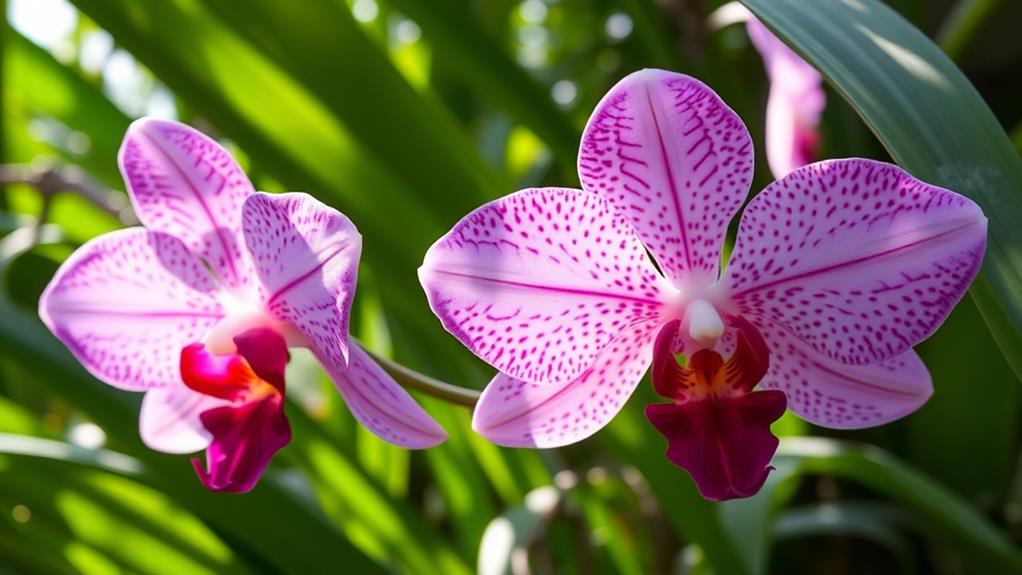
The Waling-Waling: A Symbol of Philippine Biodiversity and Cultural Heritage
The Waling-Waling, scientifically known as Vanda sanderiana, is a rare and exquisite orchid species endemic to Mindanao, Philippines. It primarily thrives in the provinces of Davao, Cotabato, and Zamboanga, growing on the trunks of dipterocarp trees.
Unique Adaptation and Growth Habit
The Waling-Waling showcases a unique adaptation to its natural habitat, featuring a monopodial growth habit with a single stem adorned with long, narrow, leathery leaves.
These leaves accentuate the orchid's exquisite flowers, which bloom between June and August, with the flowering peak varying based on local climatic conditions and altitude.
Significance and Conservation
The Waling-Waling is highly prized among orchid enthusiasts and cultivators not only for its striking appearance but also for its significance in Philippine biodiversity and cultural heritage.
As a symbol of the country's rich flora, its importance extends beyond mere aesthetics. Understanding the Waling-Waling highlights the need for conservation efforts to protect this remarkable orchid and its unique ecosystems in Mindanao.
Taxonomy and Naming
Vanda sanderiana: A Prime Example of Taxonomic Complexity
In the realm of orchid taxonomy, Vanda sanderiana stands out as a prime example of both classification complexity and botanical beauty. This species, commonly known as the Waling Waling, was named in honor of the renowned orchidologist Henry Frederick Conrad Sander.
Initial Classification and Synonyms
Vanda sanderiana was initially described by botanist Heinrich Gustav Reichenbach. The species has also been referred to by its synonyms, Euanthe sanderiana and Esmeralda sanderiana, which highlight the various attempts to categorize this stunning orchid.
Despite these earlier classifications, it's firmly registered under the Vanda classification, especially for breeding purposes.
Floral Diversity and Taxonomic Implications
The species showcases floral diversity through its two distinct forms: pink and white, with the latter known as alba. This variation not only enhances its aesthetic appeal but also complicates its taxonomy.
The pink and white forms of Vanda sanderiana demonstrate how a single species can exhibit distinct characteristics, making taxonomy more complex.
Understanding the Naming Conventions
Understanding the naming conventions and classification history of Vanda sanderiana enriches one's appreciation for the Waling Waling.
Distribution and Habitat
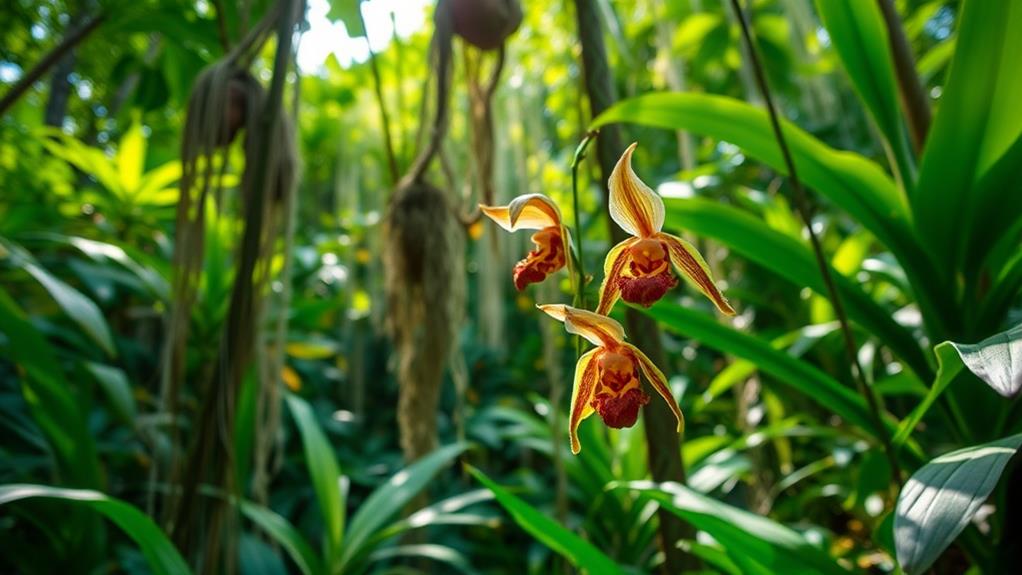
Distribution and Habitat of Vanda sanderiana
The Waling-waling orchid, Vanda sanderiana, is endemic to the Philippines, specifically inhabiting the lush rainforests of Mindanao, including the Davao, Cotabato, and Zamboanga provinces.
Habitat Requirements
This orchid thrives on the trunks of dipterocarp trees at elevations below 500 meters, favoring tropical rainforest habitats rich in biodiversity.
Key Habitat Details
| Aspect | Details |
|---|---|
| Elevation | Below 500 meters |
| Preferred Trees | Dipterocarp trees |
| Habitat Type | Tropical rainforest |
| Conservation Status | Rare, facing extinction risk |
Threats and Conservation Efforts
Habitat destruction and over-collection have made the Waling-waling increasingly rare. Conservation efforts are critical in preserving its natural habitat. Local nurseries have begun propagating the orchid through tissue culture to combat its declining population.
Varieties and Characteristics
Varieties of Waling-waling Orchid
The Waling-waling orchid, also known as Vanda sanderiana, exhibits remarkable diversity in its various forms, showcasing distinct differences in appearance and characteristics. For instance, var. froebeliana stands out with its bright rose coloration and large, striking flowers. In contrast, var. albata features smaller blooms adorned with white petals and purple spots, adding to the orchid's visual complexity.
Growth Habit and Characteristics
The Waling-waling orchid exhibits a monopodial growth habit, characterized by a single stem that produces leaves and flowers along its length. This growth pattern, combined with its long, narrow, leathery leaves, enhances the aesthetic appeal of its clustered blooms.
Additionally, var. labello-viridi closely resembles the species but is distinguished by its unique green labellum, accented with bold crimson stripes.
Hybridization and Diversity
The genetic traits of the Waling-waling make it an attractive candidate for hybridization with other Vanda orchids. This practice enriches the genetic pool and leads to the creation of diverse cultivars, each with unique characteristics.
As a result, the Waling-waling orchid remains a celebrated symbol of beauty and diversity within the orchid family.
Cultivation and Care
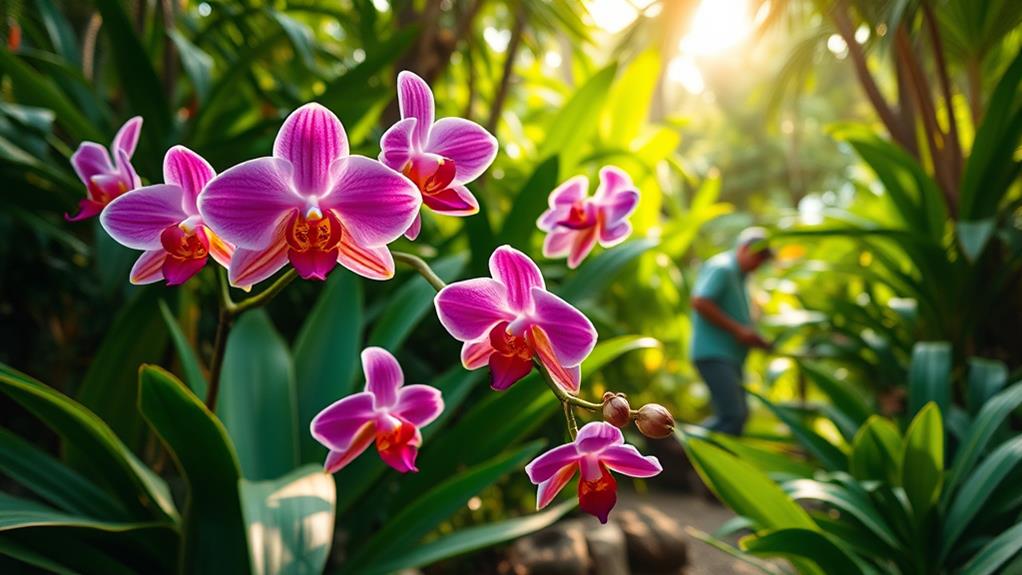
Cultivation and Care
To thrive, Waling-waling orchids require specific growing conditions. They need bright, indirect sunlight, so place them in a well-lit area. Daily watering is essential, especially in high-humidity environments, to prevent drought stress and promote healthy growth.
Use a well-draining potting medium to avoid root rot while maintaining adequate moisture levels. A mix of orchid bark, perlite, and charcoal is ideal.
Fertilization is crucial during blooming months. Regularly apply a balanced orchid fertilizer to support optimal flower production and overall plant health.
Maintain strong air circulation to prevent diseases by ensuring proper spacing between plants and ventilation.
When it comes to propagation, Waling-waling orchids can produce keikis (baby orchids). Remove keikis and repot them separately to maintain the health of your mother plant.
This practice promotes the growth of new plants and prevents nutrient depletion from the original orchid.
Cultural Significance
The Waling-waling Orchid: A Cultural Icon
The Waling-waling orchid, scientifically known as Vanda sanderiana, holds a prominent place in Filipino culture, symbolizing both beauty and tradition. It is revered as the "Queen of Philippine Flowers." This esteemed title is especially significant among the indigenous Bagobo people, who worship the orchid as a diwata, or spirit. This spiritual connection highlights the orchid's role in local traditions and practices, making it more than just a flower.
The Waling-waling's National Significance
In 2004, a motion was filed to declare the Waling-waling the national flower of the Philippines, recognizing its symbolic status among the nation's flora.
Although a Senate bill in 2013 aimed to officially recognize the Waling-waling alongside the Sampaguita, it was vetoed by President Benigno Aquino III. This decision reflects ongoing debates about the orchid's cultural recognition and significance in the national identity.
Promoting Filipino Heritage and Tourism
The Waling-waling's exquisite beauty and cultural importance have made it a popular symbol in various artworks and souvenirs.
This has further enhanced its role in promoting Filipino heritage and tourism. As a vital emblem, the Waling-waling intertwines nature and tradition, standing out in the rich cultural tapestry of the Philippines.
Conservation Status

Protecting the Waling-waling Orchid: A Symbol of Beauty and Cultural Heritage
The Waling-waling orchid, native to Mindanao, is an endangered species facing critical threats from over-collection and habitat loss.
Ongoing deforestation in regions like Davao, Cotabato, and Zamboanga jeopardizes its existence, making conservation efforts essential for maintaining biodiversity.
Conservation Strategies
To protect the Waling-waling orchid, strict regulations against over-collection must be implemented.
Additionally, natural habitats must be restored and protected through reforestation.
Promoting sustainable orchid farming practices among local communities and supporting local nurseries in propagating the Waling-waling via tissue culture are also crucial.
Furthermore, recognizing the Waling-waling as the national flower of the Philippines can raise awareness and support for its conservation.
Active Conservation Initiatives
Local organizations are actively working to conserve the Waling-waling's natural habitat and enhance public awareness.
By engaging in these efforts, individuals can contribute to the preservation of this remarkable orchid.
The rarity and unique cultural significance of the Waling-waling orchid demand collective action to ensure its survival for future generations.
Economic Importance
The Waling-waling orchid contributes significantly to the local economy of the Philippines. This is evident in Davao City, where the orchid is a central attraction, drawing tourists and boosting local businesses that cultivate and sell it as a sought-after souvenir and ornamental plant.
Tourism stimulated by the Waling-waling benefits various sectors. The influx of visitors supports local businesses, creating a positive impact on the local economy.
Additionally, sustainable farming practices associated with the Waling-waling engage local communities, providing employment and income opportunities for farmers and artisans.
The Waling-waling's reputation enhances the Philippines' standing in global horticulture. This promotes the export of native orchids and related products, further contributing to the local economy.
The orchid's cultural significance drives demand for crafts inspired by it, supporting local traditions and artisans.
In summary, the Waling-waling orchid is a vital asset in fostering sustainable growth and preserving the rich heritage of the Philippines. It's more than just a beautiful flower; it's a powerful symbol of both economic and cultural vitality.
Related Products
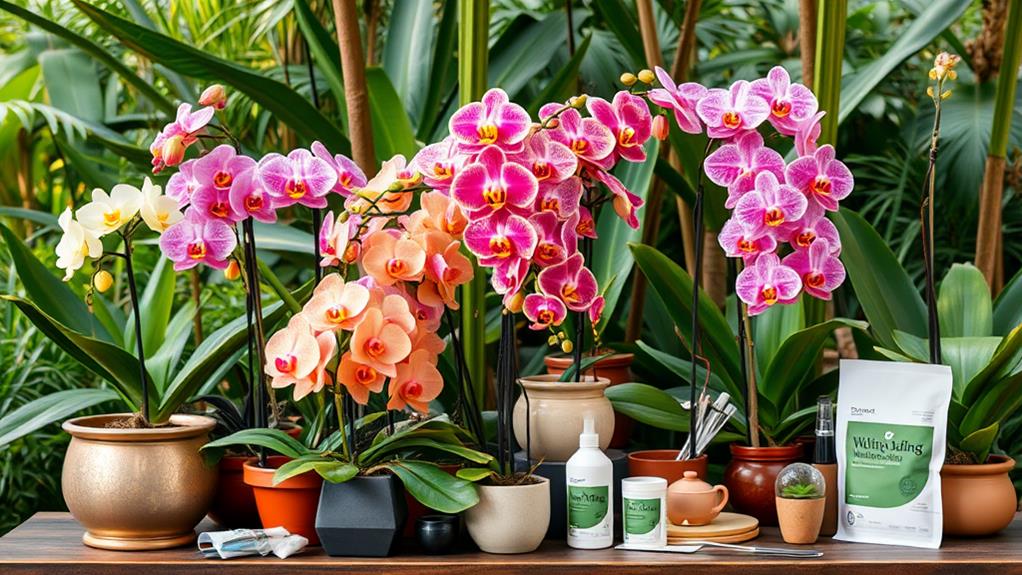
Related Products for Waling-waling Orchid Cultivation
When cultivating the Waling-waling orchid, specific products can enhance your gardening experience. These products cater to your needs in creating an environment suitable for this stunning orchid species, native to the Philippines, which thrives in high humidity.
Complementary Plant Species
Other tropical plants that share similar care requirements can be incorporated into your garden to create a cohesive landscape.
Cornutia grandiflora (Tropical Lilac) and Asplenium nidus Osaka (Birds Nest Fern) are examples of such plants, although they're currently out of stock.
Clivia miniata (Fire/Natal Lily) and Tabernaemontana divaricata Flore Pleno (Crape Jasmine) are available options, priced at $35.00 and $15.00, respectively.
Vanda orchids are also a suitable choice, with varying prices.
Benefits of Incorporating Complementary Plants
By incorporating these plants into your garden, you can create a thriving environment for all species involved.
This approach allows you to create a cohesive tropical landscape that complements the beauty of your Waling-waling orchid.
Questions and Answers
Why Is Waling-Waling Considered the Queen of the Philippines Orchid?
The Waling-Waling's Unique Characteristics Make It Stand Out
The Waling-Waling orchid boasts vibrant colors and intricate structures that set it apart from other orchids.
Its flowers feature a combination of yellow, green, and brown hues, with a distinctive shape that resembles a flying bird. This exceptional beauty is found thriving in the tropical rainforests of Mindanao, where it has adapted to a specific habitat.
Cultivation Supports Local Economies and Conservation Efforts
Cultivating the Waling-Waling not only generates income for local communities but also promotes the conservation of its natural habitat.
This, in turn, enhances biodiversity by preserving the rainforests of Mindanao.
The Waling-Waling Symbolizes Philippine Cultural Heritage
The Waling-Waling has become an iconic symbol of the Philippines, representing the country's rich cultural heritage.
Its beauty and significance connect communities and foster national pride.
What Is the Queen of the Philippines Orchids?
The queen of Philippine orchids is the Waling-Waling. This orchid is renowned for its vibrant colors and unique shape. To cultivate the Waling-Waling, it's essential to replicate its natural habitats in Mindanao by providing high humidity and filtered light.
The Waling-Waling holds significant cultural importance, particularly among indigenous communities.
However, due to its rare and endangered status, conservation efforts are vital to protect this iconic species.
Supporting conservation initiatives is crucial to preserve the Waling-Waling for future generations.
What Is the Most Expensive Orchid in the Philippines?
The most expensive orchid in the Philippines can cost up to $1,000 or more.
This high price is due to the orchid's rarity and unique beauty, making it a highly sought-after possession among collectors.
The rarity of this orchid species contributes to its high value, as it's difficult to find and cultivate.
Conservation efforts are crucial to protect these valuable plants.
With the rising popularity of rare orchid hybrids and limited availability of specific varieties, conservation efforts are essential to preserve these plants and prevent their extinction.
Without conservation, the availability of these orchids would further decrease, driving up their market value.
What Is the Rare Philippine Orchid?
The rare Philippine orchid thrives in specific habitats. These habitats are characterized by unique conditions, such as high altitudes, humid climates, and specific soil types. For example, the Paphiopedilum philippinense orchid is found in the mountainous regions of Luzon and Mindanao, where the cool temperatures and high humidity allow it to flourish.
Conservation efforts focus on protecting these habitats from threats like habitat loss. The destruction of natural habitats due to deforestation, urbanization, and agriculture has led to the decline of many orchid species. To combat this, conservation programs are working to establish protected areas and restore degraded habitats.
Orchid breeding programs aim to increase their populations while preserving their cultural significance. These programs involve the controlled propagation of orchids in controlled environments, such as greenhouses, to increase their numbers.
For instance, the Dendrobium cuthbertsonii orchid is being bred in captivity to reduce the demand on wild populations and preserve its cultural importance in Philippine traditional medicine.
By understanding these factors, you can appreciate the importance of safeguarding their ecosystems. The survival of rare Philippine orchids is dependent on the preservation of their habitats and the continued conservation efforts.
